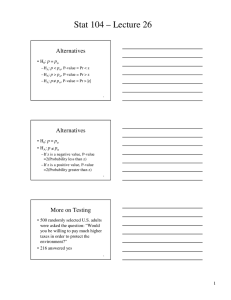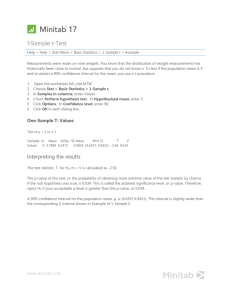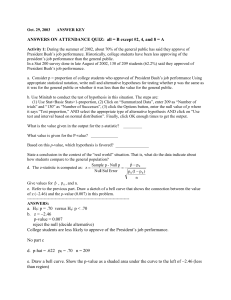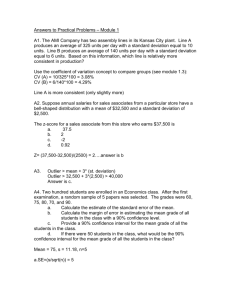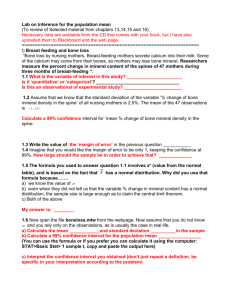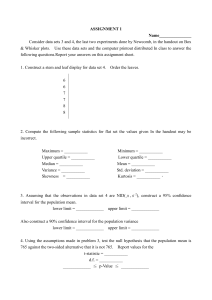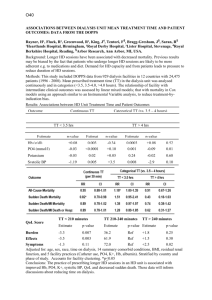Exam3-Outline
advertisement
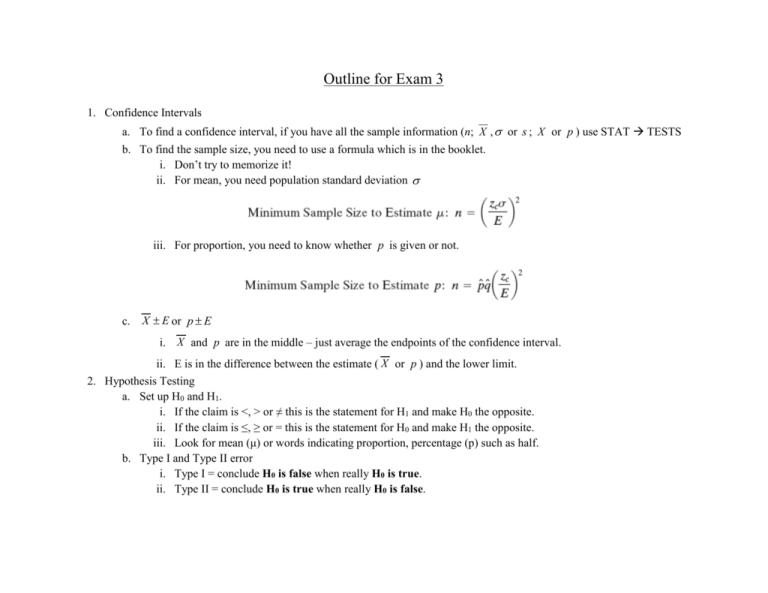
Outline for Exam 3 1. Confidence Intervals a. To find a confidence interval, if you have all the sample information (n; X , or s ; X or p ) use STAT TESTS b. To find the sample size, you need to use a formula which is in the booklet. i. Don’t try to memorize it! ii. For mean, you need population standard deviation iii. For proportion, you need to know whether p is given or not. c. X E or p E i. X and p are in the middle – just average the endpoints of the confidence interval. ii. E is in the difference between the estimate ( X or p ) and the lower limit. 2. Hypothesis Testing a. Set up H0 and H1. i. If the claim is <, > or ≠ this is the statement for H1 and make H0 the opposite. ii. If the claim is ≤, ≥ or = this is the statement for H0 and make H1 the opposite. iii. Look for mean (μ) or words indicating proportion, percentage (p) such as half. b. Type I and Type II error i. Type I = conclude H0 is false when really H0 is true. ii. Type II = conclude H0 is true when really H0 is false. c. P-Value using normalcdf i. For a left sided test, p-value = P(Z < TS) = normalcdf(-10000,TS) ii. For a right sided test, p-value = P(Z > TS) = normalcdf(TS, 10000) iii. For a two sided test, p-value = 2×P(Z > absolute value of TS) = 2×normalcdf(absolute value of TS,10000) Another way to find the p-value for the two-sided test is to double the smaller p-value from i. and ii. Don’t use normalcdf if you can use STAT TESTS because it is quicker and you don’t risk the chance of forgetting the formula. d. Critical values i. Look for the area in one tail. For left or right sided tests, this is just α. For two sided tests, this is α/2. ii. Use d.f. = n-1 if it is a test for the mean and σ is unknown. Otherwise use the bottom row of Table 5 e. To find the test statistic or p-value when you have all the sample information, use STAT TESTS. 3. STAT TESTS a. You should know this backwards and forwards for the exam. This is how you are going to have time to work 25 problems. Know the order for hypothesis testing ONLY. This includes only 6 tests. Do not try to memorize all 12. Once you know the order for the first 6, you get the next set of 6 for confidence intervals by continuing with the numbering. They are in the same order. b. See the table below. i. Hypothesis tests are the first set of 6. They have “Test” in their name. ii. Confidence Interval is the second set of 6. They have “Int” or “Interval” in their name. iii. 2 sample tests or confidence interval have “2” in their name. iv. Tests or confidence intervals for proportions have “Prop” in their name. Otherwise it is for one or two means. 1:Z-Test… 2:T-Test… 3:2-SampZTest… 4:2-SampTTest… Pooled = NO 5:1-PropZTest… 6:2-PropZTest… 7:ZInterval… 8:TInterval… 9:2-SampZInt… 0:2-SampTInt… Pooled = NO A:1-PropZInt… B:2-PropZInt… 4. Tips. a. b. c. d. Find a test statistic or p-value × × Find a confidence interval 1 group or 2 groups? 1 1 Will not use this one. × × × 2 1 2 × 1 × 1 Will not use this one. Mean(s) or Proportion(s) Mean Mean Means Proportion Proportions Mean Mean × 2 Means × × 1 2 Proportion Proportions If you have to, read the question twice. Look for key words. Don’t forget about Minitab. Don’t forget the calculator. Don’t forget to have fresh batteries.
